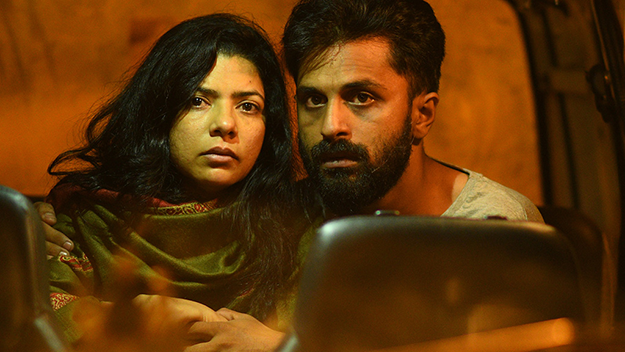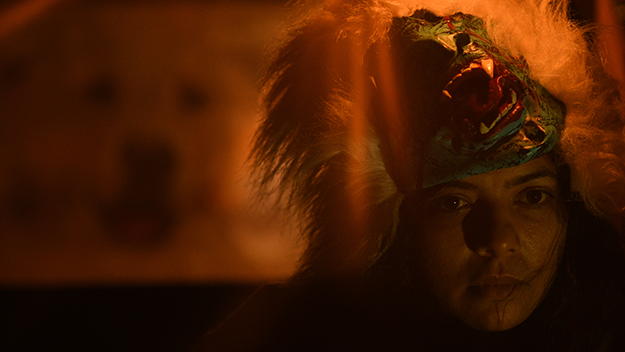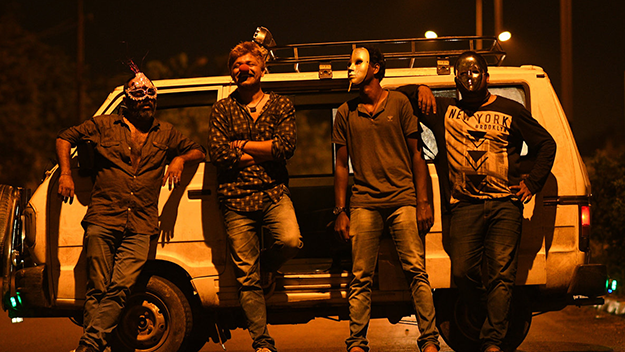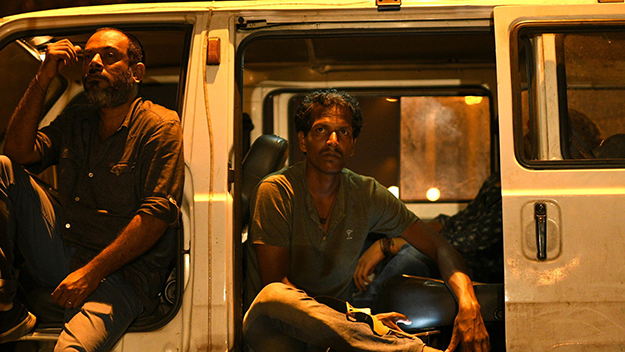ND/NF Interview: Sanal Kumar Sasidharan
As one of the founders of the Kerala-based independent film collective Kazhcha Chalachitra Vedi, Sanal Kumar Sasidharan has been a prominent figure in the recent resurgence of Malayali indie cinema, which has its roots in John Abraham’s “people’s cinema” movement of the 1980s. With his third feature, Sexy Durga, Sasidharan reflects Indian independent cinema’s emerging feminist moment, urgent more than ever at a time when films like Alankrita Shrivastava’s Lipstick Under My Burkha are being denied release in the country for being too “lady-oriented.” Sasidharan’s stringent psycho-thriller joins recent releases like Pan Nalin’s Angry Indian Goddesses (2015) and Leena Yadav’s Parched (2015) in investigating the contradictions of Indian patriarchy that make women the subjects of both worship and vilification.
In Sexy Durga, Sasidharan unfurls a diabolical nightmare on the streets of Kerala, an Indian state celebrated as “God’s Own Country” for its abundant natural splendor. A young Hindu-Muslim couple, Durga and Kabeer, elope together in the dead of the night and hitch a ride with two punkish youths who promise to deliver them to the nearby railway station. The sinister undertones of the men’s enthusiastic offers to help reveal themselves slowly through the details—the decapitated head of a goddess Durga statue that dangles in the front of their van, the abrasive thrash-metal music they insist on blasting, their leering glances at Durga, and their relentlessly intrusive curiosity about the couple’s relationship. What follows is a protracted drama of dreadful anticipation as Durga and Kabeer attempt repeatedly and futilely to escape the two men, encountering corrupt cops and menacing, meddling strangers on the way. Like Sasidharan’s acclaimed previous feature, Ozhivudivasathe Kali (2015), Sexy Durga blends giddy, atmospheric stylization—long and dynamic shots, psychedelic lighting, hair-raising music—with razor-sharp political critique, weaving a subtextual confluence of themes of gender, language, religion, and authority into the film’s bare-bones narrative.
In advance of Sexy Durga’s North American Premiere at New Directors/New Films on March 21, Film Comment spoke to Sanal Kumar Sasidharan by phone about the trials and thrills of making politically charged independent cinema in India.

“Sexy Durga” is quite a provocative title. I read that you even received some threats because of it. What made you come up with this particular title?
In all my films, I want to communicate something with the title itself. The film is about how we worship the goddess Durga, and at the same time, how we treat women on the street. On the one hand we worship, on the other hand we gang-rape. It’s highly contradictory. I wanted to put that contradiction in the beginning, in the title itself.
I guess the controversial reaction to the title confirms the irony that you’re trying to communicate with it.
Yeah, because people in this culture think Durga can only be a goddess. They don’t realize that we are encountering Durgas on the street everyday and that they are suffering. People are tutored in such a way that if you find the name Durga, you go and worship it. But if there’s a lady on the street whose name is really Durga, she might be considered a prostitute.
Two lovers from different communities and religions eloping together is a classic setup for a drama. But as a road movie, set in the dead of the night, it becomes the perfect premise for a thriller. How did you come up with the idea of shooting this as a road film?
In Kerala, and everywhere in India, nightlife is very dark and always dominated by men. Men rule the roads, and if a woman is out in the night, it’s like predators and prey. I needed this claustrophobic, closed [sense]. When you think of a road movie, you think of a lot of openness, scenery, nature. But in this movie, even though it is a road movie, you can’t see openness or nature. You can always see the closeness of these human beings, their faces, and their fear. In a road movie, you expect something visually rich, like open landscapes. Here, if you see an open landscape, you’ll be frightened. That’s why I used it.
You’ve spoken about how central gender is to this film. But a lot of other social issues also come to the fore in the course of the film. People keep referring to the fact that Durga is North Indian, and characters are suspicious of Kabeer because of his Muslim name. How did you see these issues of language and religion intersecting with the theme of gender?
It’s not just about gender. Gender is the main part, but at the same time, it’s about power. It’s power politics. That’s why, in the entire movie, you don’t see any real violence, even though the violence is there. Everyone is trying to dominate others. The police are trying to dominate the drivers, the drivers are trying to dominate the hitchhikers. It’s like a drama. If we understand that someone is more powerful, we don’t fight them—we surrender. It’s the nature of the society here, I think. So it’s not only about gender. Gender is also a power factor.

The documentary shots that bookend the film, depicting the Garudan Thookam festival in Kerala, feature graphic shots of men inserting spikes into their bodies and walking on burning coals. But the narrative part of the film has no violence, though the threat of it is a constant source of suspense and tension. What is your approach to filming violence?
I was thinking about violence—where it comes from and why it is so acceptable in our society. Nobody is against it. Everybody accepts [it]. That also has to do with power, as I said earlier. If something is violent, we will accept it.
And that acceptance of violence comes from very sacred places. Rituals, worships, sacrifice. Sacrifice is something we consider spiritual. But if you’re ready to accept bodily violence to yourself—in the name of whatever, it may be sacrifice, or worship, or love—without regret or repulsion, then you’re ready to give violence back to society, too. That’s why I used this documentary footage. You can’t call it violence, it’s pure sacrifice. People are doing harm to their own bodies in the name of worship. And if they are ready to take violence into their body then it is easy for them to give violence to others. It’s a very simple theory.
But why is there no physical violence in the narrative part of the film?
Because this graphic violence that we see nowadays in film—cutting, stabbing, blood coming out, screaming—this kind of violence is very rare in our society. But at the same time, violence is everywhere, in every moment. If you’re talking to a stranger, there’s a violence in that. The stranger has an ego, and if you hurt that ego, there is violence. We are living inside violence. That’s why I didn’t want to show actual violence. When people show it, what is the point they are making? No point.
You’re well-known for making films without scripts. Sexy Durga definitely feels very improvisatory and organic, but it’s also a tightly structured thriller. How much of the film did you plan before you started shooting?
The plan changes a lot and I’m very happy with that. My crew also knows nowadays that the plan, whatever we’re going to do, will change at the location. I have an idea in my mind and what I want to communicate is clear to me. Once that is fixed, I plan scenes and scenarios. But when we go to the location with all the artists and shooting implements, it evolves. I become an observer. I see what is happening, and according to that, I am ready to deviate, to give it its own way to work out. It’s very organic and I love to watch it happen.
How do you prepare your actors?
I never prepare my actors. I want what’s inside their minds, their experiences, the kinds of reactions they naturally have. What I say to them is don’t act, just react. I put them in a location and give them a situation. One person starts, the other reacts, then another acts… it’s like a ladder. Sometimes I don’t even give them a clear picture of what the scene will be and how it will end. I want to see how it happens and then I will shape it a little bit. It’s kind of like… shaping them in acting. There’s no rehearsal, it’s very raw. That’s why the film looks organic.

Does the narrative structure of the film come together during the editing process, then?
For me, the editing happens simultaneously while I shoot. I can see what is happening and what I need to put in the next scene. So basically, I can foresee the editing process while shooting. When the shooting is finished, my film is also finished.
Would you consider your filmmaking method to be collaborative? Do all the members of your crew have creative input in the making of the film or are you an auteur-like figure?
Everybody contributes, but they don’t know what they’re contributing. I have a complete idea of the film from the beginning, even though I have a lot of lacunae which I leave for them to fill in. But they are not contributing with awareness. I am the filter. I filter what they contribute, and if something is good, I use it. But even if something is very good, I may still not use it because of my sensibilities. So yes, it is a kind of auteur-ship. Because ultimately the film will speak what I want it to speak. It’s like using a seashell from the seashore. Whatever you like, you take, and then put it in an artwork.
The cinematography of the film is very striking, especially the long and fluid shots. Were those also improvised while shooting?
No, I had an idea of how I wanted to make this film. I concentrate on the making—the narrative structure, the way of telling the story—and not the story itself. I want to use the camera to create a mood. So I think about how I will shoot the movie and what its structure will be like way before we start shooting. Also because these kinds of camera movements take a lot of infrastructure. We made our own rigs. I already knew that these were the kinds of shots I’d take, lengthy shots. These things I’m very clear about.
The music of the film is very central to its mood. There’s this very modern, Western-sounding metal music that contrasts with the traditional music accompanying the shots of the Garudan Thookam festival. How did you come up with the music for the film?
The music director of the film, Basil Joseph, has worked with me on my last two films. I gave him the temple music as a reference. Even though you say it contrasts [with the metal music], there is some kind of similarity between them, with the loudness, the colour, everything. I told him that we needed to make something like this, but purely modern. At one point in the film, I successfully merged the two. It worked very smoothly. I wanted to show that the modern and the traditional—the primitive—coexist in society.

You started a filmmaking collective in Kerala, “Kazhcha Chalachitra Vedi,” that is known for making films that are crowdfunded, improvised, and even copyleft. I’m sure many people have drawn parallels between your society and John Abraham’s Odessa Collective. Is he a big influence in your filmmaking?
When I was studying, I followed this John Abraham style of filmmaking a lot. I had no idea how to make a film and how to find a producer. I was keenly watching these kinds of film society movements, the Odessa film movement. I read books about John Abraham, about his parallel way of filmmaking and his philosophy of the “people’s cinema.” But I wasn’t following all this practically. Then I tried to make a film on my own and approached a lot of people, but no one was willing to produce it.
I talked to my colleagues and friends and we formed a film society in 2001, the “Kazhcha Film Society.” We crowdfunded and made several short films, and in 2013 we made our first feature film, Oraalppokkam, which was also crowdfunded. Then in 2015, we made another crowdfunded feature, Eli Eli Lama Sabachthani. Now I’m not crowdfunding my own films. I have a producer, Shaji Mathew. The foundation Niv Art Movies funds my movies. But crowdfunding is going on with Kazhcha Chalachitra Vedi and we circulate films throughout Kerala through the Cinema Vandi [Cinema Cab] movement.
In addition to John Abraham, who are your other influences and inspirations when it comes to filmmaking?
Aesthetically, I was very impressed with Krzysztof Kieślowski. I was fascinated by his Dekalog. Those films directed me to this kind of filmmaking. John Abraham has not aesthetically influenced me, but his way of working has.
The films you’re making are very different from the kind of cinema that’s most popular and widely consumed in India. Do you think there is a growing appetite for indie cinema among Indian audiences?
I think so. Industry cinema is repeating itself—repeating stories, patterns, styles. People are almost tired of it. This parallel—or not parallel, but independent— cinema movement is happening everywhere in India, and slowly a lot of people are joining. But the problem is that we still have no money to advertise or to reach out to people. And people have an already set taste and mindset. We need to develop the taste for such movies, and we need to reach out to people. It will take time. But it will happen, eventually.
Since you make films about very polemical social issues, are you concerned about state censorship or adverse reactions to your films?
It’s very difficult to make films with these kinds of subjects, because people are totally opposed to these, and the government also promotes popular cinema. And if somebody opposes a film, then the government says it will cause problems, so you better don’t make it. It’s very difficult. I’m concerned about the Censor Board, the government, and even the people. But it doesn’t affect me while I’m making the film. The first thing I want to ensure is that the film I want to make should be made. There should be no influence or concern that should cause me to make a change. After the film is done, I am really concerned what will happen to it because people have put their time, energy, and money into it.







